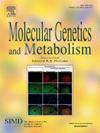Response to therapy of creatine transporter deficiency caused by a hypomorphic variant in SLC6A8
IF 3.7
2区 生物学
Q2 ENDOCRINOLOGY & METABOLISM
引用次数: 0
Abstract
Cerebral creatine deficiency syndromes (CCDS) are rare inherited metabolic disorders caused by defective biosynthesis or transport of creatine. These conditions are characterized by reduced accumulation of creatine in the brain, mild to severe intellectual disability, global developmental delay, and speech-language disorders. The amount of brain creatine reduction needed to cause symptoms is not known. Here we report a new patient with creatine transporter deficiency (CTD) who presented at 15 months of age with seizures and global delays with no speech at 3 years of age. Brain MRI was normal, but brain MRS indicated creatine levels reduced to about 20 % of normal. He had normal levels of creatine and guanidinoacetate in plasma, but increased creatine/creatinine ratio in urine. DNA sequencing identified a hemizygous c.832C > T (p.Arg278Cys) variant in the creatine transporter gene SLC6A8. Fibroblasts from this patient had about 25 % of normal creatine transport activity, a value much higher than that measured in patients whose variants introduced premature stop codons in SLC6A8. The child was started on supplements of creatine, glycine, and arginine. His speech improved dramatically, and he had no more seizures, even during episodes of fever. Despite the clinical improvement, a repeat MRS demonstrated similar levels of brain creatine. This study suggests that a reduction in creatine transporter activity to 25 % or less is sufficient to cause symptoms of brain creatine deficiency and that functionally milder forms of CTD might respond to supplements aimed at replenishing brain creatine.
由 SLC6A8 低位变异引起的肌酸转运体缺乏症的治疗反应
脑肌酸缺乏综合征(CCDS)是一种罕见的遗传代谢性疾病,由肌酸的生物合成或转运缺陷引起。这些疾病的特征是脑内肌酸蓄积减少、轻度至重度智力障碍、全面发育迟缓和语言障碍。引起症状所需的脑肌酸减少量尚不清楚。在此,我们报告了一名肌酸转运体缺乏症(CTD)的新患者,该患者在15个月大时出现癫痫发作,3岁时出现全身发育迟缓且无语言能力。脑磁共振成像(MRI)正常,但脑磁共振成像(MRS)显示肌酸水平降至正常值的 20%。他血浆中的肌酸和胍基乙酸含量正常,但尿液中的肌酸/肌酐比值升高。DNA 测序发现,肌酸转运体基因 SLC6A8 存在一个半杂合子 c.832C > T(p.Arg278Cys)变异。该患者的成纤维细胞的肌酸转运活性约为正常值的 25%,远高于在 SLC6A8 中引入过早终止密码子的变异体所测得的数值。孩子开始补充肌酸、甘氨酸和精氨酸。他的语言能力明显改善,而且不再有癫痫发作,即使在发烧期间也是如此。尽管临床症状有所改善,但重复的 MRS 显示脑肌酸水平相似。这项研究表明,肌酸转运体活性降低到 25% 或更低就足以导致脑肌酸缺乏症状,功能性较轻的 CTD 可能会对旨在补充脑肌酸的营养品产生反应。
本文章由计算机程序翻译,如有差异,请以英文原文为准。
求助全文
约1分钟内获得全文
求助全文
来源期刊

Molecular genetics and metabolism
生物-生化与分子生物学
CiteScore
5.90
自引率
7.90%
发文量
621
审稿时长
34 days
期刊介绍:
Molecular Genetics and Metabolism contributes to the understanding of the metabolic and molecular basis of disease. This peer reviewed journal publishes articles describing investigations that use the tools of biochemical genetics and molecular genetics for studies of normal and disease states in humans and animal models.
 求助内容:
求助内容: 应助结果提醒方式:
应助结果提醒方式:


